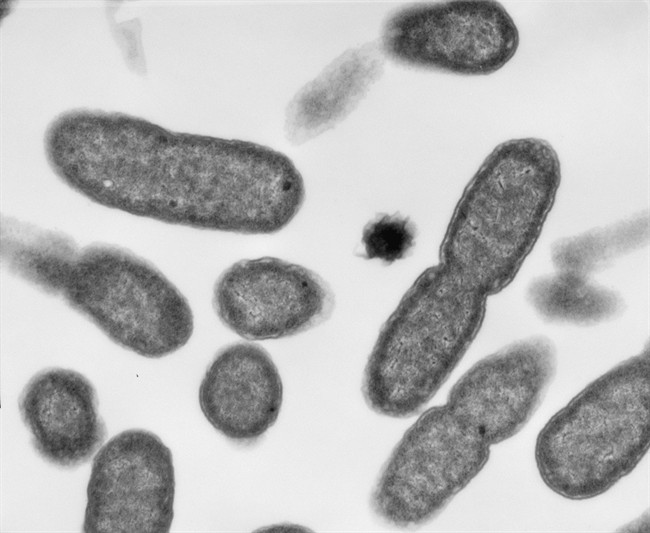It emerged on the world stage in November when Chinese researchers announced the discovery of a gene that makes bacteria into antibiotic-resistant superbugs — and it was spreading. It’s called MCR-1.

The MCR-1 gene makes E. coli and some other bacteria resistant to colistin, an antibiotic considered the drug of last resort for some infections and diseases.
The announcement of the existence of the plasmid-mediated colistin resistance, MCR-1, gene led health officials around the world to test for it.
In Canada, scientists at the Public Health Agency of Canada’s (PHAC) National Microbiology Laboratory in Winnipeg tested more than 1,000 bacterial samples collected from hospitals and provincial public health labs. Three tests came back positive, including one in a patient.
MCR-1 turned up in E. coli from an Ottawa woman who had been treated for a likely unrelated intestinal disorder in 2011 and two E. coli samples from beef sold in Ontario in 2010.
READ MORE: Meant to save your life, now overuse of antibiotics may endanger it: study
Dr. Matthew Gilmour, scientific director general of the Winnipeg lab, said PHAC scientists are now looking at earlier samples to try to determine when MCR-1 was first present in Canada. The lab has also designed a test to detect the gene. Gilmour also said the testing technology and surveillance systems are now more effective.
- Capital gains changes are ‘really fair,’ Freeland says, as doctors cry foul
- Ontario doctors offer solutions to help address shortage of family physicians
- ‘Dangerous message’: Experts slam anti-sunscreen claims circulating online
- ‘Trying not to die’: Tourism operators loaded with debt despite rising demand
Overall, public health officials are concerned about the loss of another antibiotic to resistance, “colistin is our last effective antibiotic against our most resistant group of infections called gram-negative infections,” Dr. Allison McGeer, director of infection control at Mount Sinai Hospital in Toronto, told Global News.
“In some infections you may be in a scenario where there is actually no antibiotics present that would treat the infection,” Gilmour told Global News.
“This is a fearsome scenario, where all the regular common antibiotics are resistant and now the ones that have been reserved for special purposes are also resistant, so that’s the real fear here, is that for some infections, the options for treatment are greatly limited if not gone,” Gilmour said .
What makes MCR-1 so alarming is that rather than being tethered within a chromosome, the gene is found on a circular bit of free-floating DNA called a plasmid — which can easily be swapped between bacteria, thereby allowing more micro-organisms to fend off the killing effects of antibiotics.
“It’s not only that certain strains of bacteria become resistant,” said Gerry Wright, director of the Institute for Infectious Disease Research at McMaster University in Hamilton.
“Once the genie is out of the bottle, once they start moving around, then it becomes very, very challenging to contain. And so the question we have to ask ourselves is where’s it going to end up next?”
McGeer said investing in infection prevention and control is critical. In hospitals, she recommends more careful use of antibiotics, proper hand hygiene, investment in providing more private patient rooms and a goal of fewer surgical and treatment complications would all lessen the concern.
For Canadians, McGeer has advice on what to do.
“I am going to sound like your mother…but they’re actually really important, they make a big difference,” said McGeer.
Three things Canadians can do
Prevent infections:
- Best ways to prevent infection are through safe food and safe water and to make sure your immunizations are up-to-date, recommends McGeer.
Wash your hands:
- At least five times a day – evidence shows the more you wash your hands the fewer viral infections you will have.
Antibiotic use:
- Only take antibiotics when you absolutely need them.
Wright, who first heard about MCR-1 when the Chinese scientists published their findings in the Lancet Infectious Diseases journal in November, has also begun studying the gene, with the goal of finding a means to stop it from being passed from one bacteria to another.
“What we want to be able to do, now that we know this gene is here and it’s a potential threat to human health, we want to be able to see if we can find a molecule that blocks MCR-1’s activity,” he said. “If we can find such a molecule, then we’ll be able to combine it with colistin so you could still use that drug.”
Wright said Canadians shouldn’t panic, but they should be concerned about the existence of MCR-1 because its emergence adds to the growing phenomenon of bacterial resistance to often life-saving antibiotics.
That drug resistance has developed in large part because of inappropriate and widespread use of antibiotics to fatten up beef cattle, pigs and chickens for consumption — an agricultural practice that Wright said should be banned.
“It wouldn’t be such a big deal if we had a big arsenal of antibiotics, but we don’t,” he said of MCR-1 and other resistance-conferring genes. “There are no new antibiotics coming to market.
“So that’s the reason to be scared. This has the potential to affect us all.”
With files from CP
Infographic below outlines the recommendation from The State of the World’s Antibiotics, 2015, released by the Center for Disease Dynamics, Economics & Policy (CDDEP) the authors outlined antibiotic overuse and the spread of resistance.





Comments